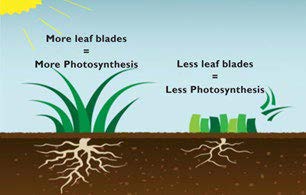The health and performance capabilities of finely mowed turfgrasses are based on the number of biochemical reactions that take place throughout the cells that eventually convert C02, Water and Sunlight into 50,000+ Proteins and Enzymes.

The efficiency of these biochemical processes is determined
by the quantity and balance of specific hormones and metabolites.
More frequent and balanced chemical reactions generally produce greater structural, defensive, and recovery strength. The key to this is keeping the plant in a constant state of metabolic equilibrium. Any imbalance will reduce overall plant strength.


 Nitrogen is the key component for protein and enzyme production, but when excess nitrogen is available then metabolic efficiency is compromised. Additional nitrogen absorbed by the plant, above what is needed, gets assimilated and translocated to the leaves.
Nitrogen is the key component for protein and enzyme production, but when excess nitrogen is available then metabolic efficiency is compromised. Additional nitrogen absorbed by the plant, above what is needed, gets assimilated and translocated to the leaves.
Excess nitrogen causes leaf blades to swell and lose texture. It also triggers topical growth due to imbalances of carbohydrate to nitrogen ratios, resulting in excess organic material, while reducing the plants natural defense against pathogens.
Mowing Low Limits Sunlight Absorption
The historical problem with highly managed turf has been that the height of cut reduces absorbed sunlight radiation, which limits the level of hormones and metabolites the plant can make and use.


GE Turf works with Turf Managers to help overcome this limited sunlight problem using Floratine products that uniquely contain critical plant-made phytohormones and metabolites, while still allowing low height of cuts.
The advantage is that when naturally driving the strength of the plant with its own plant made hormones and metabolites, then less nitrogen is required. When less nitrogen is used, turf managers can have better leaf texture, control growth, and reduce future organic material build-up in the soils.

Using Predict N7, turf managers can now dial in their inputs to a whole new level by providing their turfgrasses with the proper weekly amounts of hormones, nutrients and metabolites based on their current soil conditions and the predicted weather. They can maintain metabolic equilibrium and provide the plant with what it needs based on the upcoming weather conditions and their desired performance goals. This saves turf manages significant money and time. It also allows them to have great results with less effort by them and their team.

